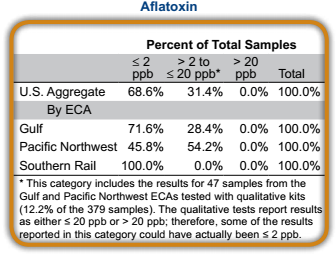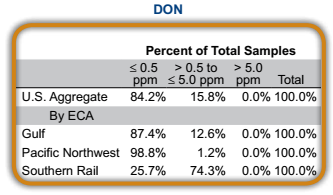Mycotoxins
Mycotoxins are toxic compounds produced by fungi that occur naturally in grains. When consumed at elevated levels, mycotoxins may cause sickness in animals and humans. While several mycotoxins have been found in corn grain, aflatoxins and deoxynivalenol (DON or vomitoxin) are considered to be two of the important mycotoxins.
The Harvest Quality Report previously presented a summary of the instances when aflatoxins or DON was detected in some of the samples at harvest. This Export Cargo Quality Report again reports on instances when aflatoxins or DON was detected in the export corn samples. No specific levels of either aflatoxins or DON are reported. As additional Export Cargo Quality Reports are conducted, they will convey the year-toyear pattern of mycotoxin presence in corn as the crop is exported.
Assessing The Presence of Aflatoxins and Don
The U.S. grain merchandising industry implements strict safeguards for handling and marketing any elevated levels of mycotoxins. All stakeholders in the corn value chain – seed companies, corn growers, grain marketers and handlers as well as U.S. corn export customers – interested in understanding how mycotoxin infection is influenced by growing conditions and the subsequent storage, drying, handling and transport of the grain as it moves through the U.S. corn export system. To assess the impact of these conditions on aflatoxins and DON development, this report summarizes the results from official FGIS aflatoxin tests and from independent DON tests for all the export samples collected as part of this survey. Details on the testing methodology employed in this study for the mycotoxins are in the “Testing Analysis Methods” section.
Testing Results
All 379 Export Cargo Quality Study samples were analyzed for aflatoxins and DON with FGIS-approved test kits. Of the 379 samples, 332 were tested for quantitative aflatoxin results. The remaining 47 samples were tested for qualitative results as required by the export contract. At the U.S. Aggregate level, the aflatoxin results for 68.6% of the samples were equal to or below 2 ppb. Results for the remaining 31.4% of the samples at the U.S. Aggregate level were between 2 and 20 ppb. All samples were below the FDA action level of 20 ppb.

The DON quantitative testing results for the 379 samples indicated that 84.2% were below 0.5 ppm at the U.S. Aggregate level. The balance of the samples’ results fell between 0.5 and 5.0 ppm. All samples were below the FDA advisory level of 5.0 ppm (10 ppm for chickens and cattle).
Mycotoxin Background: General
The levels at which the fungi produce the mycotoxins are impacted by the fungus type and the conditions under which the corn is produced and stored. Because of these differences, mycotoxin production varies across the U.S. corn producing areas and across years. In some years, the growing conditions across the corn production regions might not produce elevated levels of any mycotoxins, while in other years, the conditions in a particular area might be conducive to production of a particular mycotoxin to levels that impact the corn’s use for human and livestock consumption. Humans and livestock are sensitive to mycotoxins at varying levels. As a result, the U.S. Food and Drug Administration (FDA) has issued action levels for aflatoxins and advisory levels for DON by intended use.
Action levels specify precise limits of contamination above which the agency is prepared to take regulatory action. Action levels are a signal to the industry that FDA believes it has scientific data to support regulatory and/or court action if a toxin or contaminant is present at levels exceeding the action level if the agency chooses to do so. If import or domestic feed supplements are analyzed in accordance with valid methods and found to exceed applicable action levels, they are considered adulterated and may be seized and removed from interstate commerce by FDA.
Advisory levels provide guidance to the industry concerning levels of a substance present in food or feed that are believed by the agency to provide an adequate margin of safety to protect human and animal health. While FDA reserves the right to take regulatory enforcement action, enforcement is not the fundamental purpose of an advisory level.
A source of additional information is the National Grain and Feed Association (NGFA) guidance document titled “FDA Regulatory Guidance for Toxins and Contaminants” found at http://www.ngfa.org/files/misc/Guidance_for_Toxins.pdf.
Mycotoxin Background: Aflatoxins
The most important type of mycotoxin associated with corn grain is aflatoxin. There are several types of aflatoxin produced by different species of the Aspergillus fungus with the most prominent species being A. flavus. Growth of the fungus and aflatoxin contamination of grain can occur in the field prior to harvest or in storage. However, contamination prior to harvest is considered to cause most of the problems associated with aflatoxin. A. flavus grows well in hot, dry environmental conditions or where drought occurs over an extended period of time. It can be a serious problem in the southern United States where hot and dry conditions are more common. The fungus usually attacks only a few kernels on the ear and often penetrates kernels through wounds produced by insects. Under drought conditions, it also grows down silks into individual kernels.
There are four types of aflatoxin naturally found in foods – aflatoxins B1, B2, G1 and G2. These four aflatoxins are commonly referred to as “aflatoxins” and the sum of the four aflatoxins is called “total aflatoxins”. Aflatoxin B1 is the most commonly found aflatoxin in food and also the most toxic. Research has shown that B1 is a potent naturally occurring carcinogen in animals, with a strong link to human cancer incidence. Additionally, dairy cattle will metabolize aflatoxin to a different form of aflatoxin called aflatoxin M1 which may accumulate in milk.
Aflatoxins are toxic in humans and animals by primarily attacking the liver. The toxicity can occur from shortterm consumption of very high doses of aflatoxin-contaminated grain or long-term ingestion of low levels of aflatoxins, possibly resulting in death in poultry and ducks, the most sensitive of the animal species. Livestock may experience reduced feed efficiency or reproduction, and both humans’ and animals’ immune systems may be suppressed as a result of ingesting aflatoxins.
The FDA has established action levels for aflatoxin M1 in milk intended for human consumption and for total aflatoxins in human food, grain and livestock feed products if the levels exceed:
FDA has established additional policies and legal provisions concerning the blending of corn with levels of aflatoxins exceeding these threshold levels. In general, FDA currently does not permit the blending of corn containing aflatoxins with uncontaminated corn to reduce the aflatoxin content of the resulting mixture to levels acceptable for use as human food or animal feed.
Corn exported from the U.S. must be tested for aflatoxins according to Federal law. Unless the contract exempts this requirement, testing must be conducted by FGIS. Corn above the FDA action level of 20 ppb cannot be exported unless other strict conditions are met. These requirements result in relatively low levels of aflatoxins in exported grain.
Mycotoxin Background: DON (Deoxynivalenol) or Vomitoxin
DON is another mycotoxin of concern to some importers of corn grain. It is produced by certain species of the Fusarium fungus, the most important of which is F. graminearum (Gibberella zeae) which also causes Gibberella ear rot (or red ear rot). The fungus can be spotted easily in corn because of the conspicuous red discoloration of kernels on the ear. The presence of Gibberella zeae is mostly a problem when warm, wet weather occurs at flowering. The fungus grows down the silks into the ear, and in addition to producing DON, it results in damage to kernels that are evident during the grain inspection process. DON and Gibberella ear rot is most common in the northern Corn Belt states. This may be due to the susceptibility to the fungus of very early maturing corn hybrids commonly grown in these areas.
DON is mostly a concern with monogastric animals where it may cause irritation of the mouth and throat. As a result, the animals may eventually refuse to eat the DON-contaminated corn and may have low weight gain, diarrhea, lethargy, and intestinal hemorrhaging. It may cause suppression of the immune system resulting in susceptibility to a number of infectious diseases.
The FDA has issued advisory levels for DON. For products containing corn, the advisory levels are:
- 5 ppm in grains and grain by-products for swine, not to exceed 20% of their diet,
- 10 ppm in grains and grain by-products for chickens and cattle, not to exceed 50% of their diet, and
- 5 ppm in grains and grain by-products for all other animals, not to exceed 40% of their diet.
FGIS is not required to test for DON on corn bound for export markets, but will perform either a qualitative or quantitative test for DON at the buyer’s request.
